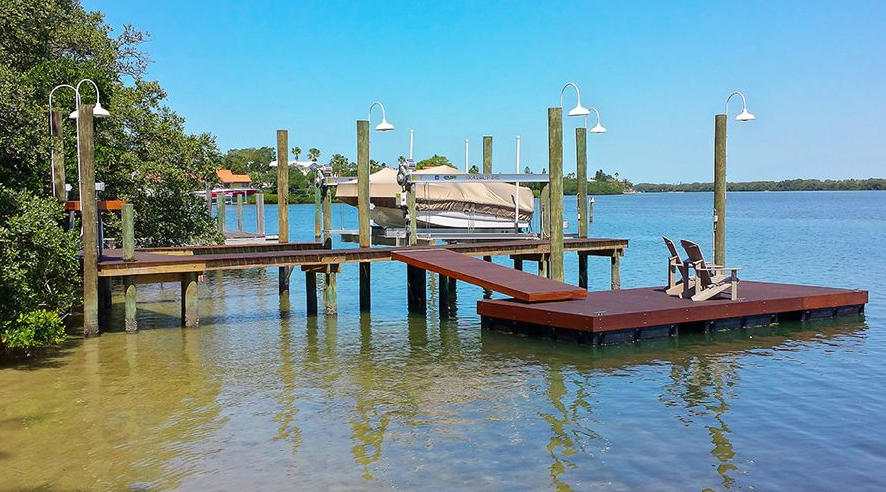Explore the Series Of Floating Dock Solutions Designed to Suit Every Boater's Demands
Upgrade Your Beachfront With Long Lasting Floating Docks
Upgrading your beachfront with sturdy floating docks can substantially improve both performance and aesthetics, giving a versatile remedy for numerous water activities. These structures are developed to adapt to fluctuating water degrees, making sure security and access throughout the periods. With an array of materials readily available, consisting of low-maintenance options and traditional timber, choosing the best dock can match your personal design and satisfy useful demands. Comprehending the subtleties of setup and upkeep is crucial for making sure longevity and efficiency. What variables should you take into consideration when making this investment?
Advantages of Floating Docks
Floating docks deal a wide variety of benefits that boost their allure for numerous maritime applications. One of the main advantages is their versatility to transforming water degrees - floating docks. Unlike standard set docks, floating docks fluctuate with the tide, making certain consistent access for watercrafts and boat no matter of environmental conditions. This feature considerably decreases the danger of damages to vessels, as they remain safely anchored even during changes in water depth.
Additionally, floating docks are much easier to relocate and set up, providing versatility for seasonal or short-lived use. Their modular style enables customization to fit particular demands, whether for personal marinas, residential beachfronts, or commercial applications.
Moreover, floating docks create minimal disturbance to the marine setting, maintaining local communities and minimizing the possibility of disintegration. They also give improved safety and security and security for individuals, as their buoyant nature provides a more flexible surface area than inflexible structures.
Additionally, floating docks can assist in a diverse variety of tasks, such as fishing, swimming, and leisure boating, making them a useful property for waterfront advancement. Their flexibility and functionality make floating docks a preferred option for a variety of naval jobs.
Choosing the Right Products
Selecting appropriate products for floating docks is crucial to their longevity, performance, and overall efficiency. When picking products, consider aspects such as environmental exposure, upkeep needs, and structural honesty. Common materials include wood, plastic, aluminum, and composite options, each offering distinctive benefits and drawbacks.
Wood, while cosmetically pleasing, calls for normal maintenance to avoid rot and decay. Pressure-treated timber can improve sturdiness, however it might still catch water damage with time. Plastic drifts, typically made from high-density polyethylene, are resistant to corrosion and need very little upkeep, making them an attractive option for low-maintenance applications.
Light weight aluminum is another viable option, known for its stamina and lightweight residential or commercial properties. It is immune to corrosion and can hold up against harsh climate condition, although it might be much more pricey than various other materials. Composite materials incorporate the most effective attributes of timber and plastic, supplying a durable and low-maintenance alternative that imitates the appearance of timber without the linked drawbacks.
Ultimately, the option of material ought to align with the meant usage, environmental factors to consider, and budget plan restraints, making certain a sturdy and useful floating dock that fulfills your details requirements.
Installment Refine Introduction
The effective installment of a Discover More drifting dock counts on careful planning and execution, making certain that it runs efficiently in its desired environment. The initial step entails analyzing site conditions, including water deepness, shoreline features, and dominating climate patterns, which will notify the dock layout and anchoring system.
Complying with the website evaluation, the next phase is to prepare the floating dock components. This consists of setting up the framework, protecting floats, and connecting any essential hardware. It is important to make sure go to my blog that all connections are waterproof and durable to stand up to aquatic conditions.
As soon as the dock is assembled, the installation procedure commences with positioning the dock in the water. This can involve a crane or various other training tools, especially for larger structures. Proper alignment is necessary for capability and security.

Maintenance Tips for Durability
Routine maintenance is essential for making certain the durability and optimum performance of a floating dock. To accomplish this, start with regular assessments at the very least twice a year, concentrating on the integrity of the dock's structure, including the flotation tools and connecting equipment. Search for signs of rust, wear, or damage, and deal with any issues quickly to stop further damage.
Cleansing is an additional crucial element of maintenance. Eliminate debris, algae, and barnacles from the dock's surface to stop unsafe conditions and maintain aesthetic charm. Make use of a soft brush and a light cleaning agent to stay clear of harming the dock's materials.
Furthermore, make certain that the dock is correctly anchored and secured to stand up to seasonal changes in water degrees and weather. Inspect the anchoring system for security and make modifications as necessary.
Enhancing Your Outdoor Aesthetic
To produce a visually appealing outside room, including a drifting dock can substantially improve website link the general aesthetic of your waterfront residential or commercial property. Floating docks are not just functional but can additionally serve as a striking prime focus that complements the natural environments - floating dock builder. Available in different materials and layouts, these docks can be personalized to match your residential or commercial property's architectural design and landscape
The addition of decorative components, such as incorporated illumination or stylish barriers, even more raises the dock's visual allure. Think about utilizing all-natural wood surfaces, which blend seamlessly with the environment, or choosing for contemporary materials like aluminum or composite outdoor decking that offer a streamlined, modern look.
Strategically positioning planters or seating locations on or around the dock can produce welcoming rooms that motivate leisure and satisfaction of waterfront views. Furthermore, integrating colors and appearances that integrate with your landscape will certainly create a cohesive visual throughout your exterior area.

Conclusion

Updating your waterfront with resilient floating docks can substantially improve both performance and visual appeals, providing a versatile service for numerous water tasks. Unlike traditional set docks, floating docks surge and autumn with the tide, ensuring regular access for boats and boat regardless of ecological conditions.Selecting ideal products for floating docks is important to their longevity, performance, and general efficiency.Once the dock is put together, the setup procedure commences with positioning the dock in the water.In summary, floating docks offer many advantages, consisting of adaptability to water degree modifications and a variety of product options.